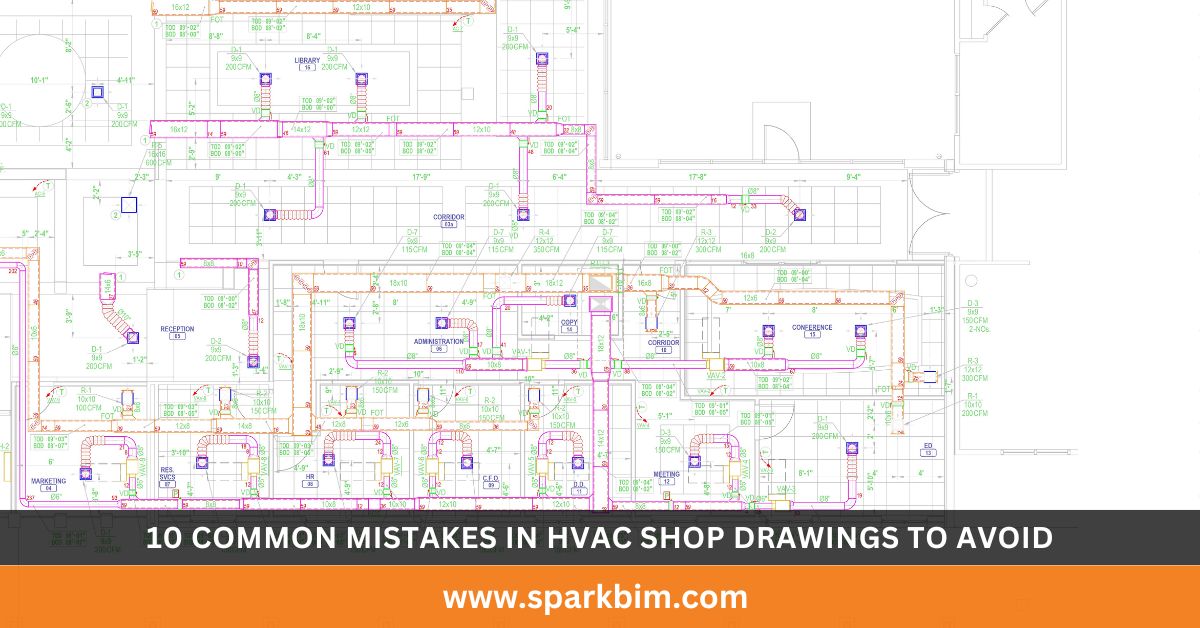Table of Contents
ToggleHVAC systems are one of the most essential parts of any modern building. Whether it’s an office, school, hospital, or shopping mall, proper heating, ventilation, and air conditioning are essential for comfort and safety.
One key part of installing an HVAC system is creating HVAC Shop Drawings. These are detailed technical drawings that show how the system will be installed.
But like any technical work, mistakes can happen. There are many mistakes in HVAC shop drawings to avoid if you want your project to run smoothly. These mistakes can lead to delays, added costs, or even system failure.
In this blog, we will cover the most common errors and how you can avoid them. Let’s dive in!
What Are HVAC Shop Drawings
HVAC shop drawings are detailed diagrams created during the construction process. They illustrate how the HVAC system – comprising ductwork, air handlers, vents, and mechanical rooms – will be installed according to the design provided by the engineers or architects. These drawings are used by contractors, HVAC installers, and inspectors to guide the construction process.
Unlike basic design drawings, shop drawings contain more detail. They reflect actual field conditions and help identify conflicts before installation begins. These documents are also used to ensure proper coordination of HVAC systems with other trades, such as plumbing, electrical, and structural components.
Because of their importance, it’s critical to understand the mistakes in HVAC shop drawings to avoid them, especially if you’re working on a large or complex project.
10 Common Mistakes in HVAC Shop Drawings to Avoid
1. Inaccurate Measurements and Scaling
One of the biggest mistakes to avoid in HVAC shop drawings is using incorrect measurements or scaling. This can lead to significant problems during installation. Imagine cutting a hole in the wall or ceiling for a duct, only to find out it’s too small – or worse, too large.
Why It Happens
This usually occurs when the original site measurements are rushed or based on outdated building plans. Sometimes, errors also arise from not properly adjusting the scale of the drawing in the software.
How to Avoid It
Always double-check field measurements and compare them with the architectural floor plans to ensure accuracy.
Use laser measurement tools when possible and have a second person verify critical dimensions. This will help prevent duct layout conflicts, equipment misalignment, and installation delays.
2. Poor Coordination with Other Trades
Another common mistake in HVAC shop drawings to avoid is failing to coordinate with other trades properly. HVAC systems often share space with plumbing pipes, electrical conduits, sprinkler systems, and structural beams. If these elements aren’t coordinated, they may clash during construction.
Why It Happens
This typically occurs when HVAC drawings are created in isolation without verifying the complete MEP drawings (Mechanical, Electrical, and Plumbing) as a whole.
How to Avoid It
Use BIM modeling tools to identify conflicts in advance. BIM (Building Information Modelling) enables all trades to collaborate in a 3D environment. This makes it easy to spot and resolve clashes before construction begins. Regular coordination meetings between all stakeholders are also helpful.
3. Ignoring Manufacturer Specifications
Each HVAC product – like air handlers, chillers, fans, and ducts – comes with manufacturer guidelines. These include minimum clearances, weight limits, airflow requirements, and other relevant specifications.
Why It Matters
Ignoring manufacturer specs is a grave mistake in HVAC shop drawings to avoid. It can void warranties, reduce energy efficiency, and even cause system failure.
How to Avoid It
Always consult the product documentation and include all necessary installation requirements in your shop drawings. Ensure your team is trained to understand and apply this information effectively.
4. No Allowance for Maintenance and Service Access
HVAC systems need regular maintenance to work efficiently. If your shop drawings place a unit in a tight or inaccessible area, it will be difficult for technicians to do their job later on.
Why This Is a Problem
Limited access can lead to higher service costs, equipment breakdowns, or safety risks. It’s another critical mistake to avoid in HVAC shop drawings.
How to Avoid It
Design with future service in mind. Leave enough space around units for filter changes, coil cleaning, and motor replacement. Label these access zones clearly in your shop drawings.
5. Inconsistent Use of Symbols and Notations
A typical communication problem in construction comes from unclear or inconsistent symbols. HVAC drawings use symbols to represent fans, ducts, air terminals, thermostats, and other components.
Why This Creates Confusion
If every drawing uses different symbols or abbreviations, contractors and installers may get confused. This leads to errors and delays.
How to Avoid It
Follow standard drawing conventions from organizations like SMACNA (Sheet Metal and Air Conditioning Contractors’ National Association) and ASHRAE. Use consistent symbols and create a legend for each drawing set. That way, everyone stays on the same page.
Also Read, MEP Coordination Checklist
6. Failing to Update Drawings After Design Changes
During construction, changes often happen. A wall may get moved, or a structural beam may be added. If your HVAC drawings aren’t updated to reflect those changes, serious issues can occur.
Why It’s a Problem
Installers will be working off outdated plans, which can lead to installation mistakes or the need to redo work. It’s one of the easiest, yet most overlooked, mistakes in HVAC shop drawings to avoid.
How to Avoid It
Keep a strict revision control system. Mark all changes clearly with dates and version numbers. Utilize cloud-based project management tools to ensure everyone has access to the latest versions of the drawings.
7. Incorrect Duct Sizing
Ducts that are too small will restrict airflow. Ducts that are too large consume unnecessary space and incur higher installation costs. Getting the duct sizing wrong is a common mistake in HVAC shop drawings that should be avoided.
Why It Matters
Poor airflow can lead to hot and cold spots, higher energy bills, and customer complaints.
How to Avoid It
Use trusted software to calculate proper duct sizes based on airflow rates, velocity, and system type. Always account for pressure loss due to bends and transitions. This is a key part of mechanical design.
8. Overcomplicating the System Design
Sometimes, designers attempt to overcomplicate the HVAC system by incorporating too many parts, routes, or controls. While the system might look impressive on paper, it can be a nightmare to install and maintain.
Why This Happens
Overdesign often stems from trying to “cover all bases” or failing to understand the building’s real needs.
How to Avoid It
Keep your HVAC system as simple as possible while still meeting performance goals. Focus on efficiency and ease of installation. Simpler systems are usually more reliable and easier to fix.
9. Not Planning for Future Expansion
Buildings change over time. If your HVAC system doesn’t allow for future additions or upgrades, it can limit your growth potential.
Why It’s a Problem
You may need to replace or expand the HVAC system earlier than expected, which increases costs and downtime.
How to Avoid It
Design for flexibility. Leave room in mechanical rooms. Include spare capacity in your systems. Mention possible future routes in your duct layout and drawings.
10. Missing Important Documentation
Drawings without supporting notes and schedules can leave installers guessing. If the installer doesn’t understand the intent, mistakes will happen.
Why This Is Risky
Missing data leads to incorrect installations, code violations, and inspection failures.
How to Avoid It
Always include
- Equipment schedules
- Control diagrams
- Detailed notes
- Material specs
Good documentation supports better decision-making in the field.
Best Practices to Avoid These Mistakes
Now that you know the top mistakes in HVAC shop drawings to avoid, let’s look at some key tips to keep your project on track:
- Use Advanced Software – Tools like AutoCAD, Revit, and Navisworks help ensure precision and accuracy.
- Follow Industry Standards – Stick to SMACNA and ASHRAE guidelines.
- Coordinate Early and Often – Collaborate with all MEP teams from the beginning.
- Keep Things Clear and Simple – Easy-to-read drawings reduce the chance of error.
- Train Your Team – Make sure everyone understands the purpose and format of the shop drawings.
Final Thoughts
Creating HVAC shop drawings isn’t just a technical task—it’s a critical step in the construction process. Making errors in these drawings can cause serious issues down the line, so it’s essential to get them right from the beginning.
By understanding the most common mistakes in HVAC shop drawings to avoid and applying best practices, you can save time, reduce costs, and deliver successful projects.
Whether you are a contractor, engineer, or project manager, taking the time to review and improve your HVAC drawings will always pay off in the long run.


